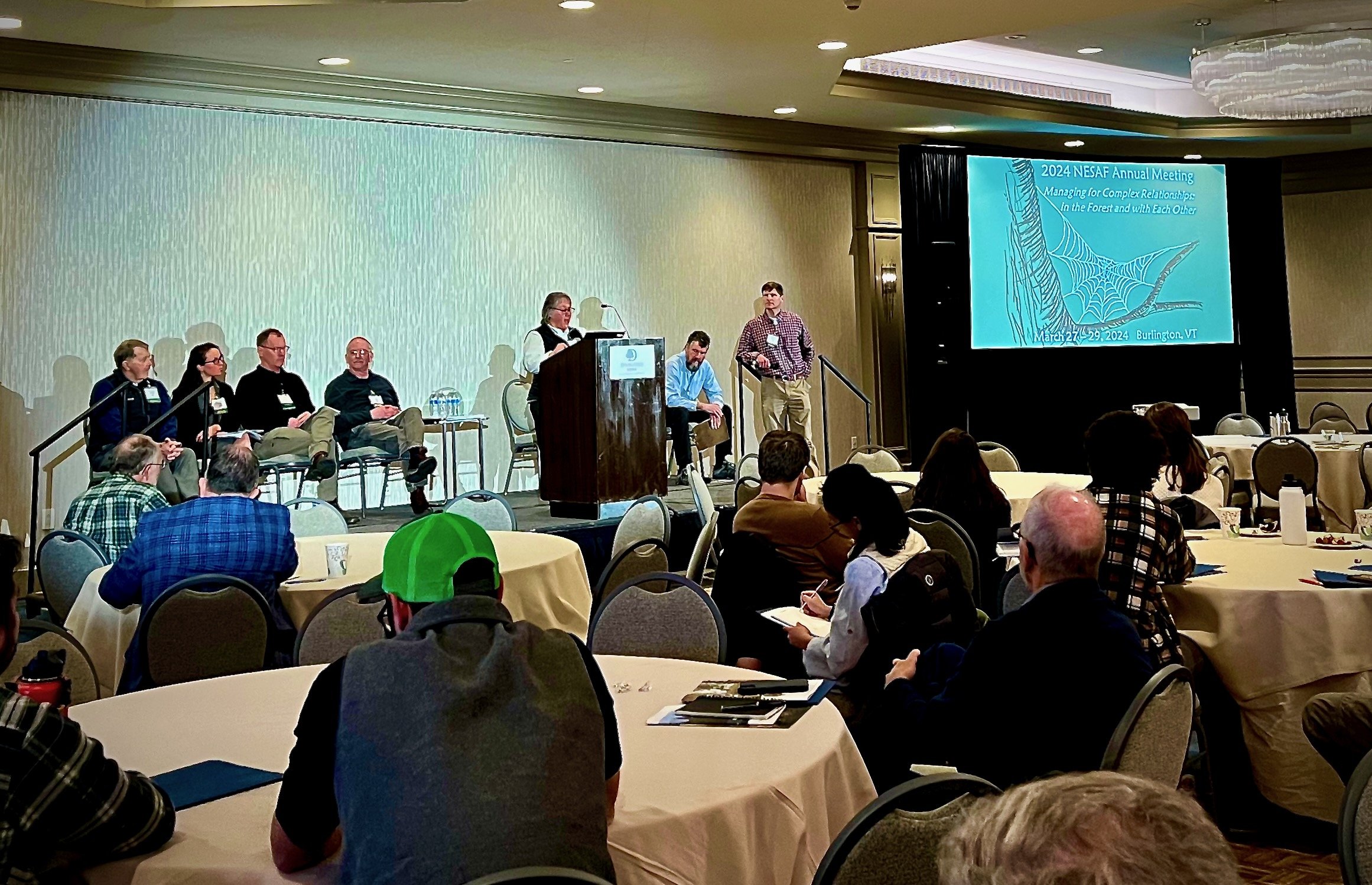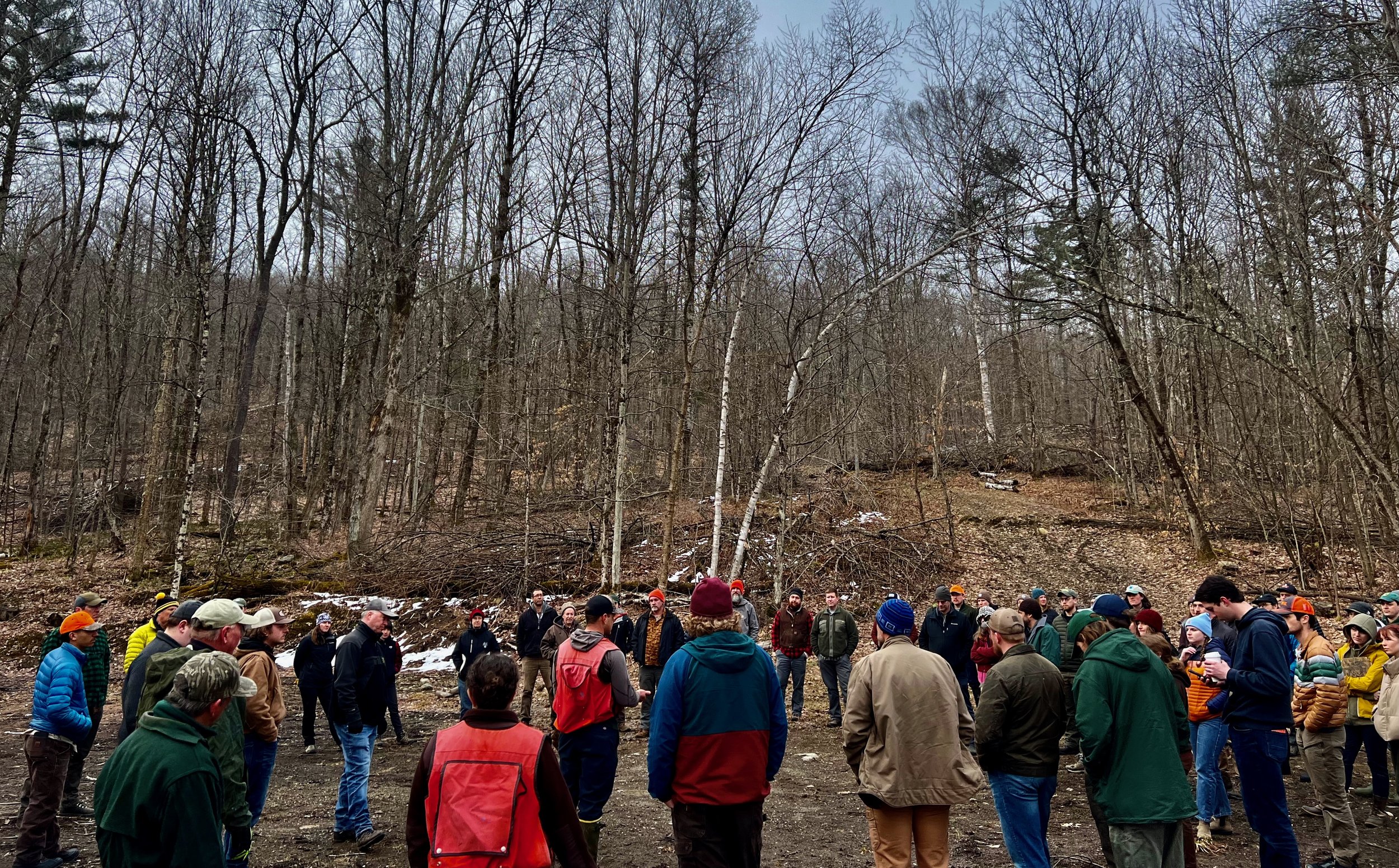NESAF Conference: Highlights of a Regional Gathering
From the outside, the focus of the discussion at this year’s gathering of the New England Society of American Foresters might be a bit surprising. Certainly, speakers shared the latest science and new technical guidance as you might expect from an annual gathering of forestry professionals; continuing education credits were issued and branded hats and pens were handed out freely. But, this year’s gathering featured discussions focused on building a set of skills most commonly employed while out of the woods: storytelling and communication. In her remarks, Dr. Coeli Hoover, a research ecologist with the U.S. Forest Service, based in New Hampshire, suggested to participants that they probably didn’t choose a career in the woods “for the glamor, the big bucks, or the paperwork … but because you freaking love forests!” And yet, the threads of discussion that carried throughout the program seemed to center the importance of the interpersonal as much as the silvicultural. Attendees were encouraged to tell the story of forests to a wider audience, not only to build robust, long-term plans and relationships with landowners but also as an essential element in an increasingly public division over how to best support forests as climate solutions.
This theme of communication and coalition-building emerged first as exploring how to build a shared understanding on the relative roles of active and passive forest management. Or, put more simply: How can the forestry profession convince environmental advocates, landowners, public officials, and anyone invested in maximizing the forest’s potential as a climate solution that they’re all on the same team? Building consensus around any particular set of management practices will require solid data and strong and persuasive messaging.
A significant portion of the conference program was dedicated to building a compelling narrative in favor of active forest management, where appropriate, as a triple win. The arguments for active management go something like this: 1) carefully planned and executed harvests can help forest resilience over time by creating conditions more favorable to diverse forest composition and structure; 2) expanding the market for durable wood products can increase the amount of carbon locked up for long periods of time; and 3) the value of forests as an economic engine cannot be ignored as a driver of rural community integrity and viability. Elements of these themes, along with justification for passive management in some places, were introduced almost immediately in the opening panel reflecting on the new report Beyond the ‘Illusion of Preservation’, and were addressed throughout the following sessions. We discuss and offer reflections on the new report elsewhere in this issue.
The opening plenary session featured Beyond the ‘Illusion of Preservation’, and several panelists who reflected on its findings. From left to right: Lincoln Fish, Caitlin Littlefield (main presenter), Michael Snyder, David Publicover, Julie Renaud Evans (at podium), Brian Donahue, and Anthony D’Amato. Photo © Alexandra Kosiba
Put simply, our society needs wood. We use it now for building, heating, packaging, and more. We will continue to use it for the foreseeable future. Even if any given acre of forest is going to store the most carbon or provide the best habitat if it is left untouched, we’re still going to use wood, and we’d be best served by finding a way to harvest it locally, process it locally, and manage our forests as best as we can. Though the consulting foresters, researchers, small-holding landowners, and industrial-scale forestry representatives in attendance all likely have different ideas about what type of “management” is needed, the attendees and speakers present all appeared ready to start from the same place: Even with some areas designated as passively managed Wildlands, active forest management has a major role to play in the future of New England, so let’s get it right. There was less discussion of what “getting it right” meant—with different conceptions, definitions, and tolerances of “ecological forestry” left without thorough examination—and more discussion on how to get everyone else on board.
This question of “bringing people along” was discussed at a very tactical level throughout the three days of discussion. Andy Goodman kicked off the second day of proceedings by coaching attendees through telling honest, compelling, and authentic stories. Goodman, and Hoover in a subsequent session on “Talking Carbon,” encouraged participants to lean into their passion and to share it widely, arguing that emotion and care resonate with listeners and that stories are guaranteed to come up short in convincing anyone of anything if they remain untold. Whether the listener is a landowner mulling over the future of their woodlot, a land trust considering options for stewardship of conservation lands, or an audience of policymakers at a public hearing, the stories that are most effective in shaping outcomes are those where the storytellers share their whole truth.
The need for greater understanding of a balanced approach to management was made readily apparent in a session on “Large Land Management” that walked participants through the latest updates in several high-profile forest management conflicts around the region: from the Healey-Driscoll administration’s reevaluation of logging on Massachusetts’ public lands to more contentious disputes about harvests planned by the U.S. Forest Service and Vermont Department of Forests, Parks and Recreation in the Telephone Gap National Forest and Camel’s Hump State Forest, respectively, to the drop in timberland acres under active management in the Connecticut Headwaters in northern New Hampshire due to the new ownership group’s commitment to carbon markets as their primary revenue source. In each of these scenarios, with different geographies and different stakeholders, management decisions are being challenged in the public sphere, and panelists agreed that stronger storytelling and communication from the forestry community had a chance to shift the political equation.
Following the formal indoor sessions, participants gathered at several field sites, such as the Catamount Community Forest in Williston, Vermont, to see active and passive management approaches in action, and to discuss the merits of different approaches. Photo © Alexandra Kosiba
The efficacy of articulating one’s own story with the land was powerfully reinforced in Leslie Jonas’ keynote address to close the conference. Where communication may or may not be a commonly deployed skill for the foresters of New England, storytelling has been at the core of Indigenous relations with land and waters for millennia. Jonas, as a teacher, researcher, and visionary in the practice of weaving Indigenous knowledge and perspective into Western conservation and environmental justice circles, shared a different conception of story and community as held by members of the Mashpee Wampanoag Tribe, specifically, and Indigenous relations with land and place more broadly. Where conference sessions leading up to Jonas’ presentation circled around supporting foresters in bringing others into a common understanding on the need for some active management, Jonas challenged the premise. Indigenous communities were not “managing” forests during the ten thousand years prior to colonization, displacement, and subjugation; rather, communities included the landscapes of our region as kin, in reciprocity and in balance. Welcoming the land, waters, and species with which we coexist as family members, rather than as resources, extends a different and powerful type of care, stewardship, and respect—all of which are embodied through the stories, experiences, and relationships that play a central role in generational transfer of culture and knowledge within Indigenous communities. Beyond sharing her own history with the land, Jonas shared stories collected as part of a series of four videos on the Indigenous Teachings with the Earth Mother’s four elements of Earth, Air, Water and Fire. The “Water” mini-documentary provided a platform through which relatives of the rivers, ponds, and ocean in the territory of the Mashpee Wampanoag shared their stories of relation and connection to the lands and waters of what is now known as Cape Cod. (To learn more about the documentary project, see a writeup of the series in Read/Watch/Listen or watch the videos in full at the Native Land Conservancy.)
Regardless of what your vision for the future of New England forests looks like or what you think should or shouldn’t be done with any particular piece of land, the encouragement, first, to consider the interdependent relationship between yourself and your landscape, and, second, to tell your story honestly and deliberately, gives us all a good chance to see a future for forests that we can be proud of.


